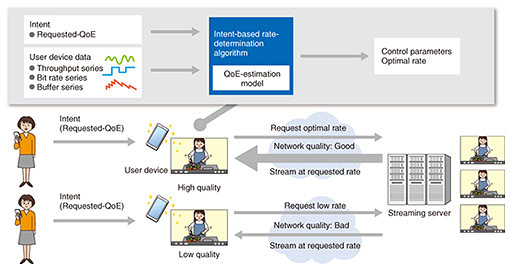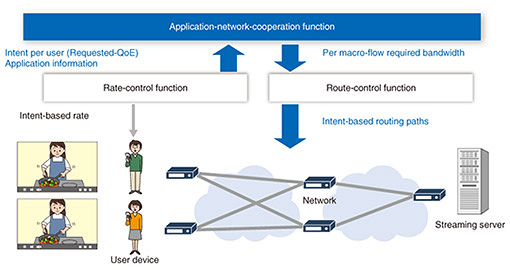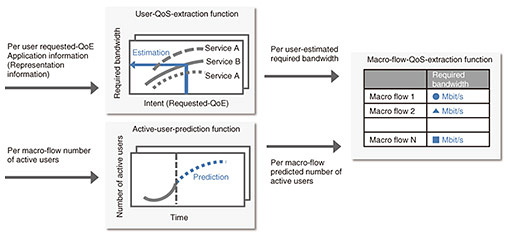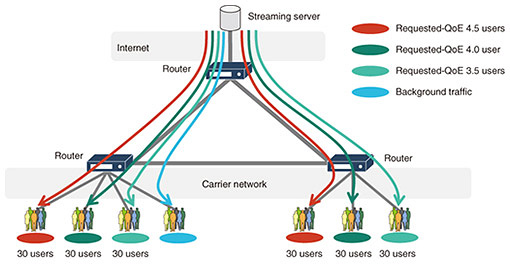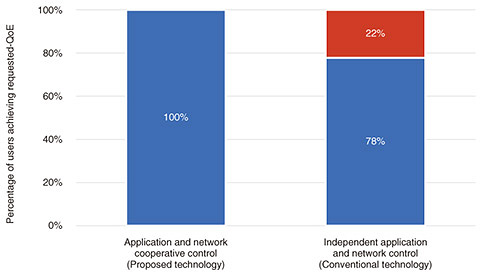 |
|||||||||
|
|
|||||||||
|
Feature Articles: Intent-based Application, Cloud-server, and Network Collaboration Technologies Vol. 20, No. 9, pp. 64–69, Sept. 2022. https://doi.org/10.53829/ntr202209fa9 Intent-based Application and Network Cooperative Control Technology for Video-streaming ServicesAbstractWe have been conducting research and development to implement the intent AI (artificial intelligence) mediator called Mintent, a technology concept that enables cooperation among application control, network control, and cloud server control on the basis of user requirements (intent) to increase user satisfaction. To implement Mintent, we propose a technology to enable cooperation between application control and network control by using intent as a common index for video-streaming services. This article provides an overview of this technology and discusses its effectiveness determined through simulation. Keywords: intent, video streaming, cooperative control 1. IntroductionWith the development of network virtualization technologies such as software-defined networking and network functions virtualization, networks can be dynamically and flexibly controlled. However, services over networks are becoming more diverse, and the requirements for networks are becoming more complex, such as ultra-high speed, high capacity, ultra-low latency, ultra-low power consumption, and low cost. For users to comfortably use services, it is necessary to understand the user’s requirements (intent) for various services, extract resource requirements to satisfy the intent, and control the services on the basis of the established resource requirements. In user applications, the transmission rate of application data is traditionally controlled in consideration of network quality to improve user satisfaction with the service. The information obtained in the network is used to control the routes that satisfy the given network-quality requirements. However, since application and network controls are independent, they may not be fully effective in terms of user satisfaction and network-resource utilization efficiency. Therefore, an approach needs to be taken to increase user satisfaction by making application and network controls cooperate on the basis of intent. We are engaged in research and development to implement the intent AI (artificial intelligence) mediator called Mintent, a technology concept for multi-layer cooperative control of applications, networks, and cloud servers on the basis of intent. As an initial study for implementing Mintent, we focused on video-streaming services, which are widely used and use a large amount of network resources, and propose a technology to enable cooperation between application and network controls on the basis of intent. This article provides an overview of this technology and the results of simulations to evaluate its effectiveness. 2. Issues in application and network controls for video-streaming servicesThis section provides an overview of application and network control technologies for video-steaming services and the issues that arise when these controls operate independently. 2.1 Rate control technology for streaming video in applicationsAdaptive bitrate (ABR) is one of the application controls at the user device that controls the rate of video streaming. In ABR, multiple-bitrate videos of different quality are pre-populated on the video-streaming server, and the application controls the rate request by switching the bitrate of the video to the streaming server in accordance with network quality such as throughput. This enables the application to increase, for example, user satisfaction by reducing playback stops. As shown in Fig. 1, we also developed a technology for predicting future quality of experience (QoE) using our QoE-estimation technology [1] on the basis of throughput measured at the user device and application information (video/audio bitrate time-series information, etc.), and controlling rates to satisfy the QoE set by the user (requested-QoE) in the application [2]. This technology ensures higher user satisfaction than conventional technologies. However, when network quality deteriorates due to congestion, application control alone cannot satisfy the requested-QoE because it can only lower the bitrate and reduce video quality. Thus, application control alone cannot maintain user satisfaction when network quality deteriorates.
2.2 Network control technologyCurrent network control technology estimates quality of service (QoS) by using traffic forecasts for each traffic flow on the basis of communication logs observed with network devices and controls routes so that the resource-utilization efficiency is high while maintaining actual QoS. Traffic flow is communication traffic with the same source Internet protocol (IP) address, destination IP address, port number, and protocol number. We developed a technology that groups flows with similar characteristics into macro flows by using non-negative tensor factorization then accurately predicts future traffic for each macro flow by using seasonal autoregressive integrated moving average (SARIMA) [3, 4]. Network control using accurate traffic prediction improves the efficiency of network-resource utilization. Therefore, the network control technology controls routes on the basis of the actual QoS estimated from communication logs, but it is difficult to correctly estimate the QoS required to satisfy a user’s desired QoE from communication logs alone. The QoS required to satisfy the user’s desired QoE is called the requested-QoS. Therefore, if there is a large discrepancy between the requested-QoS and the actual QoS, the QoE may decrease due to insufficient quality, or network-resource-utilization efficiency may decrease due to excessive quality. In addition, if the application-rate control technology described above and network control technology operate independently in video delivery, the QoE may not be satisfied. When network quality degrades due to congestion, the application-rate control technology delivers low-quality video to resolve the congestion. In this case, the network control technology determines that congestion is naturally resolved and does not change the route. As a result, low-quality video continues to be delivered and the QoE decreases. Thus, the network control technology alone cannot satisfy the requested-QoE because requirements of the requested-QoS cannot be accurately estimated and the effect of the application-rate control technology cannot be taken into account. 3. Intent-based application and network cooperative control technologyTo solve the problem of application and network controls operating independently in video-streaming services, our proposed technology enables cooperation between these controls by using the requested-QoE, one of the intents, as a common index for application and network controls. This section describes the overall structure and details of the main functions of the proposed technology. 3.1 Overall structureThe overall structure of the proposed technology is shown in Fig. 2. The technology consists of a rate-control function and a route-control function using our technology described above, and an application-network-cooperation function that enables cooperation between these functions. In the rate-control function, the user sets the requested-QoE for each user device, and the user device notifies the application-network-cooperation function of the requested-QoE and the representation information (a list of video and audio bitrates, video resolution, and frame rate that can be selected by the rate control). The application-network-cooperation function predicts the required bandwidth as future QoS requirements for each macro flow that bundles flows of users with the same requested-QoE on the basis of the requested-QoE for each user notified by all user devices. Network control satisfies the requested-QoE by executing optimal routing for each macro flow to satisfy the predicted required bandwidth. Therefore, application control and network control enable intent-based cooperative control by using the requested-QoE as a common index.
3.2 Application-network-cooperation functionAs shown in Fig. 3, the application-network-cooperation function consists of a user-QoS-extraction function, active-user-prediction function, and macro-flow-QoS-extraction function. The user-QoS-extraction function calculates the network QoS requirements on the basis of the throughput required from the requested-QoE and application information reported through user devices. The relationship between the requested-QoE and throughput required to achieve it depends on the representation information designed for each video-streaming service. Therefore, the relationship between the requested-QoE and required throughput is modeled in consideration of the representation information, and the model is used to estimate the required throughput from the requested-QoE and representation information. The active-user-prediction function predicts the future number of active users for each macro flow. It derives this number using SARIMA, a time-series prediction method, from the time-series data of the number of active users for each macro flow notified from user devices to the application-network-cooperation function. The macro-flow-QoS-extraction function calculates the required bandwidth for each macro flow on the basis of the estimated required throughput per user and the predicted number of active users per macro flow. These functions enable network routing to be controlled on the basis of network requirements considering the requested-QoE.
4. Effectiveness evaluation through simulationTo evaluate the effectiveness of the proposed technology, we compared it with conventional technologies in which application control and network control operate independently and evaluated its effectiveness in terms of user satisfaction and network-resource-utilization efficiency through simulations. This section provides an overview of the simulations and the results. 4.1 Simulation overviewThe simulation scenario assumes routing control when one path is congested in a network structure where network bottlenecks are duplicated, such as a point of interface between a carrier network and the Internet. Simulations were conducted using ns-3, an open source network simulator. Figure 4 shows the simulation environment. The network structure consists of three routers fully mesh-connected in a triangular structure. There is one video server connected to one router and 90 user terminals connected to each of the remaining two routers. There are also two routes between the video server and user devices. User devices can set their requested-QoE taking values from 1.0 to 5.0 to 4.5, 4.0, or 3.5, and 30 user devices with each requested-QoE were connected to each router. Congestion was generated by flowing background traffic to the video server from a user device. The effectiveness of the proposed and conventional technologies was evaluated by comparing the results of routing control during congestion in terms of achieving the requested-QoE and network-resource-utilization efficiency.
4.2 Effectiveness verification through simulationFigure 5 shows the percentage of users who achieved the requested-QoE after routing with the proposed and conventional technologies during congestion. About 22% of all users did not achieve the requested-QoE with the conventional technology. When limited to users with a requested-QoE of 4.5, about two-thirds did not meet the requested-QoE. This is because the network control was unable to correctly estimate the required bandwidth because it derived this bandwidth using only the information in the network and could not take into account the requested-QoE or application control. The proposed technology satisfied the requested-QoE for all users. This is because this technology estimates the required bandwidth to satisfy the QoE with higher accuracy than the conventional technology by using the requested-QoE obtained from the user-device application. Thus, the proposed technology can achieve higher user satisfaction than the conventional technology. In addition, if the percentage of users who achieved the requested-QoE with the conventional technology by increasing the link bandwidth is equal to that with the proposed technology, a 16% increase in link bandwidth is required. This indicates that the proposed technology is superior to the conventional technology in terms of network-resource-utilization efficiency.
5. ConclusionToward the implementation of Mintent, we proposed an intent-based application and network control cooperation technology for video-streaming services. We have shown that the proposed technology achieves higher user satisfaction and network-resource-utilization efficiency than the conventional technology in which application control and network control operate independently. In the future, we will develop a technology that can be applied universally to various services. In addition to application control and network control, we also aim to develop a multi-layer cooperative technology that includes cloud-server control. References
|
|||||||||









